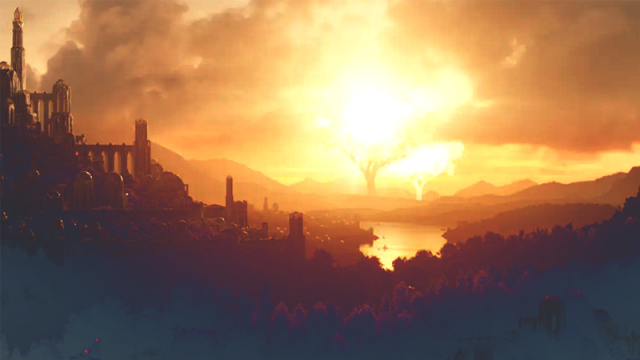A few weeks ago, Amazon gave us a beautiful first look at its new Lord of the Rings TV series, a prequel set thousands of years before the seminal fantasy saga. But in doing so, it gave us a glimpse of a time even further before that — teasing a depiction of some of J.R.R. Tolkien’s earliest Middle-Earth theology in the process.
What are the trees in Amazon’s Lord of the Rings?
We know that Amazon’s series is primarily set during the Second Age, a period of time in Tolkein’s fictional mythology of Arda — the world of Lord of the Rings, a fantastical mirror of our own Earth — that spans over three thousand years. But curiously, our first look at the show presented us with a time in Tolkein’s vast chronology much earlier than that, even before the First Age itself. How do we know that? Well through two trees, basically. The bright light from the distant right side of the fantastical city glimpsed in the teaser image helped us identify the area as not being of Middle-Earth (as we’d know it in The Lord of the Rings), but ancient Valinor. That’s the realm populated by the angelic Valar, their heavenly subservients, the Maiar, and eventually the Elves, on the western continent of Aman. Specifically, it’s because that light is emanating from two trees, Laurelin and Telperion that, before the literal creation of the Sun and Moon, were actually the source of light and twilight for the entire world.
How do the Trees of Valinor work?
Known as the two trees of Valinor, and for their status as marking an age of roughly 14,000 years (known appropriately as the Age of the Trees), Laurelin and Telperion were created by the Ainur Yavanna, the celestial member of the Valar responsible for all natural things that grew on Arda. Prior to their existence, Arda was lit by two massive lamps: lluin at the north of the world, and Ormal at the south. After the rebellious Ainur Melkor — the source of primal evil in Arda who became the first Dark Lord — destroyed the two lamps, the remaining Ainur of the Valar relocated to Aman. There, Yavanna grew Telperion and Laurelin, sustained by the tears of her fellow Ainur, Nienna, as the new source of light for the world.
Laurelin and Telperion both glowed two different colours of light together, creating a single day that lasted twelve hours (Note: Time… worked different for the Valar, even beyond their immortality — they recorded its passage quite unlike us or the future denizens of Middle Earth). Telperion, like the lamp Iluin before it, emitted a silvery-hued light, while Laurelin’s light, like Ormal’s, was golden. Dew from the trees was gathered by another member of the Valar, Varda, and formed the basis for the starlight in the sky that projected over the rest of Arda, as Telperion and Laurelin’s light only primarily projected across Valinor itself.
How Were the Trees of Valinor Destroyed?
Naturally, as the destroyer of the two lamps, Melkor was a little miffed at the Valar simply just recreating new forms of them for their new home in the West for thousands of years. Striking a deal with the primal night spirit Ungoliant — the mother of all giant spiders on Arda, from who they took their form — Melkor spirited his way to the hill Ezellohar, where Laurelin and Telperion were rooted, and struck the two trees from darkness, allowing Ungoliant to feast on their sap and drain them their light, killing them in the process.
But some trimmings of the two trees survived Melkor and Ungoliant’s attack. As Yavanna and Nienna worked to try and revive the trees, they managed to only save the last flower of Telperion, and the last fruit grown from Laurelin. Stored in special vessels created by the Ainur craftsman Aulë, the flower and fruit were given to two of the Maiar, Arien and Tilion, who carried them into the skies to form the Sun and Moon, respectively, and became their guardians. The creation of the heavenly bodies and their first rising heralded the end of the Years of Trees, and the end of Valar chronological reckoning, as dawn of the First Age brought about the marking of time for the rise and fall of the Sun and Moon.
All this is to say then, that just as with the Lord of the Rings movies before them — which opened with Galadriel recalling the final days of the Second Age and the Last Alliance between Elves and Men to defeat Sauron — when we finally get to see Amazon’s Lord of the Rings series in September 2022, we’re going to be opening with a bit of a history lesson. One that, in part, will delve into some of Tolkein’s oldest and most fascinating worldbuilding for his work, if our glimpse of Telperion and Laurelin is anything to go by. How deeper and further into that history the series goes remains unknown — there’s something quite funny that our first ever look at the show at large is this obfuscated image from well before the rest of the series’ presumed events — but in terms of seeing some of Tolkein’s vast mythology rendered in live action, well… the future’s looking quite bright.
